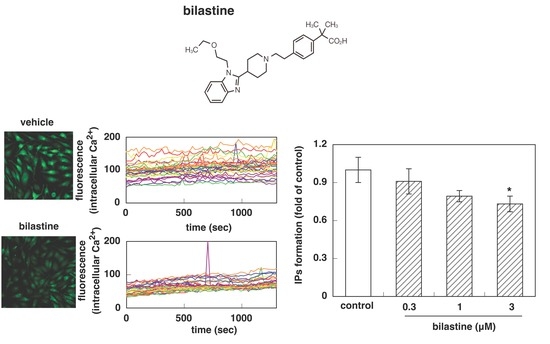Elucidation of Inverse Agonist Activity of Bilastine
1
Laboratory of Pharmacology Faculty of Pharmacy Osaka Ohtani University, Osaka 584-8540, Japan
2
Department of Molecular Pharmacology, Institute of Biomedical Sciences, Tokushima University Graduate School, Tokushima 770-8505, Japan
3
TIMELAPS VISION INC., Saitama 353-0004, Japan
4
Department of Otolaryngology, Institute of Biomedical Sciences, Tokushima University Graduate School, Tokushima 770-8505, Japan
5
Medical Corporation Kinshukai, Osaka 558-0011, Japan
*
Author to whom correspondence should be addressed.
Pharmaceutics 2020, 12(6), 525; https://doi.org/10.3390/pharmaceutics12060525
H1-antihistamines antagonize histamine and prevent it from binding to the histamine H1 receptor (H1R). Some of them also act as inverse agonists, which are more potent than pure antagonists because they suppress the constitutive H1R activity. Bilastine is a non-sedative antihistamine which is one of the most satisfy the requirements for oral antihistamines. However, there is no information to show the inverse agonist activity of bilastine including inositol phosphates accumulation, and its inverse agonist activity is yet to be elucidated. Here we evaluated whether bilastine has inverse agonist activity or not. Intracellular calcium concentration was measured using Fluo-8. Inositol phosphates accumulation was assayed using [3H]myo-inositol. The H1R mRNA level was measured using real-time RT-PCR. At rest, Ca2+ oscillation was observed, indicating that H1R has intrinsic activity. Bilastine attenuated this fluorescence oscillation. Bilastine suppressed the increase in IPs formation in a dose-dependent manner and it was about 80% of the control level at the dose of 3 μM. Bilastine also suppressed histamine-induced increase in IPs formation to the control level. Furthermore, bilastine suppressed basal H1R gene expression in a dose-dependent manner. Data suggest that bilastine is an inverse agonist. Preseasonal prophylactic administration with bilastine could down-regulate basal H1R gene expression in the nasal mucosa and ameliorate the nasal symptoms during the peak pollen period. View Full-Text
Keywords: H1-antihistamines; histamine H1 receptor gene expression; inositol phosphates accumulation; inverse agonist; time-laps Ca2+ imaging
▼ Show Figures
This is an open access article distributed under the Creative Commons Attribution License which permits unrestricted use, distribution, and reproduction in any medium, provided the original work is properly cited


No comments:
Post a Comment